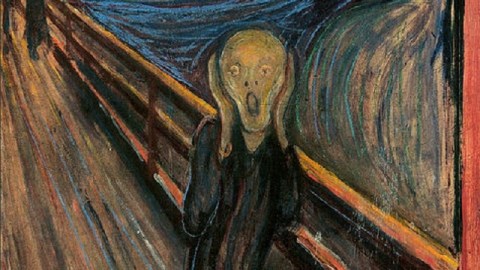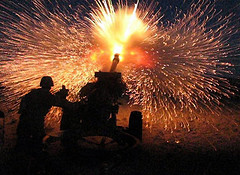Has the Art Market Lost its Mind?

These are crazy times, so why should the art market be immune? However, there’s madness and then there’s sheer madness. Only half over, the month of May 2012 might go down as the maddest month in art market history (at least until the next spate of insanity). Kicking off with the purchase of a pastel version of Edvard Munch’s The Scream (detail of another version shown above) for a new auction record of $119.9 million USD, the irrationality has risen seemingly day by day. Why in the midst of a global recession is the art market booming? Has the art market lost its mind? Or should we all be screaming over how this boom is even possible?
On May 1st, five bidders battled for 12 minutes at Sotheby’s in New York before an unidentified telephone bidder emerged victorious with the winning bid, eclipsing the $106.5 million USD Picasso’s Nude, Green Leaves and Bust commanded two years ago. Rumored buyers include Russian businessman Leonard Blavatnik, Microsoft co-founder Paul Allen, and the Al Thani family that has ruled Qatar since 1825—the top 1% of the global one-percenters. Even with 15 of the 76 total lots failing to sell, The Scream sale at Sotheby’s totaled $330.56 million USD, more than the pre-sale estimate of $323 million USD. This wasn’t a one-hit wonder. It was a full barrage of buying excess.
But wait… there’s more! The week after The Scream sale, a sale of postwar and contemporary art took in $388.5 million at Christie’s and a sale of Impressionist and modern art garnered $266.6 million at Sotheby’s. Souren Melikian of The New York Times said it was a week of blockbuster art sale profits that “conclusively proved that the disconnect of the art market from the broader economy is now radical.” In other words, the mega-rich have always paid prices for art that make the 99% gasp, but the latest prices paid have made many cringe and, perhaps, angry. On the night that The Scream set the new record, Occupy Wall Street protesters demonstrated outside the auction hall against Sotheby’s shoddy labor relations with the people they pay to handle the pricy art. Upon hearing the news, however, the protesters’ focus shifted toward the new record. “It exemplifies the ways in which objects of artistic creativity become the exclusive province of the 1 percent,” complained one protester. The other three versions of The Scream are now safely in Norwegian museums, protected as national treasures. What will happen to number 4 is a mystery, for now. But the people of Norway and the people of the world had no voice in what its fate might be. All we can do is scream.
Los Angeles Times art critic Christopher Knight believes that “art prices reflect income inequality.” Knight rightfully calls the current art market “a freak show,” before asking “what price for a pastel drawing would transform a freak show into a respectable sale: $40 million? $10 million? $50,000? Even that last sum bumps up against the annual median income of an American family.” Although some see “obscenity” in Munch’s art and that of others attracting such prices, Knight argues that “[t]he obscenity isn’t in the astronomical sums art has been fetching, it’s in the circumstances that make those prices possible.”
I agree with Knight wholeheartedly. First, the economic power players claimed the economy as their personal plaything, seizing riches for themselves and preaching austerity to everyone else. Now, those same economic elites look to take the cultural heritage of the world and literally hang it in their guest room. I can’t help but think of that scene in Dr. No when Sean Connery’s James Bond does a double take when he sees Goya‘s Portrait of the Duke of Wellington (which had been stolen in real life and was missing at the time the film was made) hanging on the wall of the title villain’s lair. The Scream and other works may have been lawfully bought, but the cash behind many of those sales was collected on the blurry borders of financial crime. Maybe these buyers will donate these works to museums where the world at large will get to see them again. But I find that storyline as implausible as that of a Bond film, but one where the bad guys win.
[Image:Edvard Munch. The Scream (detail), 1893.]





